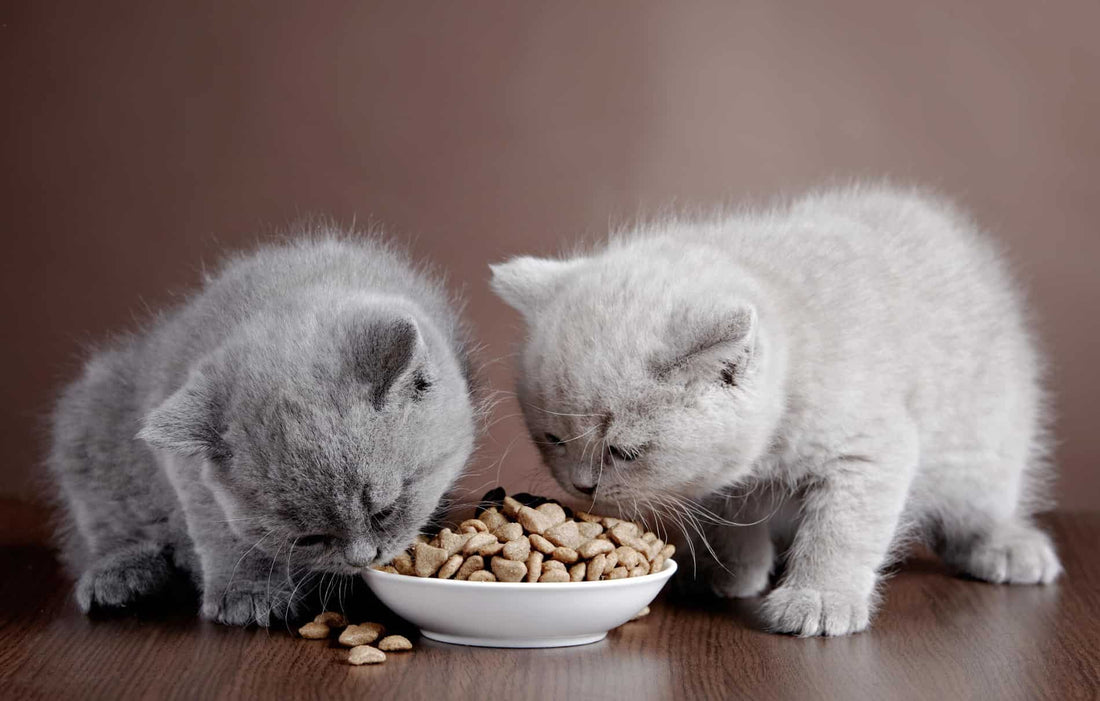Feeding your feline friend isn't just about filling up a bowl right?
Let’s talk about ensuring they receive the right nutrition for their age, stage of life, and weight. Just like humans, cats have unique dietary needs that change over time. Let's get into how much food your cat needs based on these factors.
|
Table of Content:
|
Factors that decide how much food to feed your cat?
1. Age:
Kitten (0-12 Months):
These little furballs grow rapidly during their first year of life. Because of all that growing, they require more calories and nutrients than adult cats to support this growth. Feed them a diet specifically formulated for kittens, offering a buffet of snacks throughout the day. Here's a breakdown to make it easy for you:
- 2-4 months: Kittens should be fed approximately 1/4 to 1/3 cup of dry kitten food per day, divided into 3-4 meals.
- 4-6 months: Increase the daily portion to around 1/3 to 1/2 cup, divided into 3 meals.
- 6-12 months: Gradually transition to feeding twice a day, providing 1/2 to 3/4 cup of food per day.
Adult (1-7 Years):
So, once your furball hits adulthood, their growth slows down, and their energy needs aren't bouncing all over the place. Now, instead of constantly munching, they're more into the regular meal routine.
- Average weight (8-10 lbs): Feed around 1/3 to 1/2 cup of dry food per day, split into 2-3 meals.
- Overweight (>10 lbs): Reduce portion sizes to promote weight loss, aiming for about 1/4 to 1/3 cup per day.
Senior (7+ Years):
When your kitty starts hitting those golden years, things slow down a bit. They're not bouncing off the walls like they used to, and they might start dealing with some health issues as they get older. Transition them to a senior-specific diet and offer smaller, more frequent meals to aid digestion:
- Average weight: Continue feeding 2-3 meals a day, providing about 1/4 to 1/3 cup of food per meal.
- Underweight: Increase portion sizes slightly to prevent weight loss and ensure they receive adequate nutrition.

2. Stage:
sterilized/Spayed:
Sterilized or spayed cats have lower energy requirements than intact cats. For them you need to:
- Adjust food intake to account for lower energy requirements.
- Consider specialized formulas for neutered/spayed cats.
- Measure portions and encourage regular exercise to prevent weight gain.
Pregnant/Nursing:
Pregnant or nursing cats have increased energy and nutrient needs to support themselves and their kittens. Feed them high-quality kitten food.
- Increase calories and nutrients to support pregnancy or nursing.
- Supplement diet if needed and ensure adequate hydration.
- Monitor closely for signs of appetite loss or dehydration postpartum.

Consultation with a Veterinarian:
Always consult your vet for personalized feeding recommendations.They can assess age, weight, health status, and lifestyle for tailored advice.

3. Weight:
Underweight:
If your cat is underweight, it's time to increase their food intake gradually to help them reach a healthy weight. Here's how to feed an underweight cat:
-
Underweight kittens: Offer slightly larger portions to provide the extra calories needed for growth. Aim for 1/2 to 3/4 cup of food per day, divided into multiple meals.
-
Underweight adults: Increase portions to about 1/2 to 3/4 cup per day, split into 2-3 meals. Opt for nutrient-dense foods to promote weight gain and overall health.
Ideal Weight:
- Maintaining an ideal weight is crucial for your cat's health. To ensure they stay at a healthy weight. Here's how to feed a cat at their ideal weight:
-
Adults: Stick to recommended portion sizes based on weight, ensuring they neither gain nor lose weight. Monitor their body condition regularly and adjust portions as needed.
Overweight:
If your cat is overweight, Collaborate with your veterinarian to develop a weight loss plan tailored to their needs. Here's how to feed an overweight cat:
-
Overweight adults: Gradually decrease portion sizes to promote weight loss. Aim for around 1/4 to 1/3 cup of high-quality weight management cat food per day.
- Encourage physical activity to help them burn off excess calories.
Here are links to some cat food recommendations for you to refer to making it easy for you and your Cat.
-
Age:
-
Kitten (0-12 Months): Kitten food
-
Adult (1-7 Years): Adult Cat Food
-
Senior (7+ Years): Ageing cat food

-
Stage:
-
Sterilised/Spayed: Neutered Cat Food
-
Pregnant/Nursing: Royal Canin- Mother & BabyCat

-
Weight:
- Underweight adults: Royal Canin- Light Weight

Some commonly asked FAQs:
How often should I feed my cat?
Typically two meals a day for adults, more frequent for kittens, and smaller, more frequent for seniors.
What if my cat is overweight?
Gradually reduce food intake and increase exercise; consult a vet for a weight management plan.
What if my cat is underweight?
Gradually increase food intake with nutrient-rich, calorie-dense food.
Can I feed my cat human food?
Some human foods are safe in moderation, but others can be harmful. Consult your vet for advice.
How do I switch my cat's food?
Gradually mix new food with old over 7-10 days to avoid digestive upset.
How much water should my cat drink?
Cats should drink about 1 ounce of water per pound of body weight per day. Ensure fresh water is always available.
Can I give my cat treats?
Yes, but in moderation. Choose treats that are low in calories and specifically made for cats.
In wrapping up, feeding your cat means considering how old they are, what stage of life they're in, and how much they weigh. Making sure they get the right mix of nutrients and keeping an eye on how much they eat helps them stay healthy and happy.






